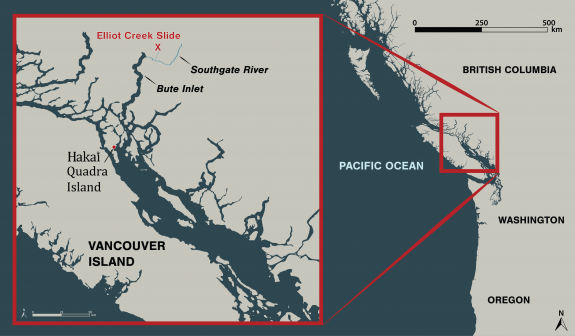Bute Inlet Landslide: The Extended Cut
Come with us into a helicopter as it flies over this landscape-altering event.

In the early morning hours of November 28, 2020, a chunk of mountain broke free and slid into a glacial lake in a remote part of the British Columbia coast 110 kilometers northeast of Campbell River. The amount of rock that fell into the lake could fill BC Place stadium five times, and triggered a 100-meter-high tsunami that ripped through Elliot Creek.
The landslide and video clips of the resulting destruction made headlines in numerous news outlets. While video snippets gave some sense of the scene, our Hakai Institute team filmed the entire 50-minute helicopter flight along what’s left of Elliot Creek, up to the lake and glacier, and back down to where Elliot Creek meets the Southgate River that flows into Bute Inlet. A map in the bottom left references the location of the helicopter during the corresponding video.
This video from December 17 represents an early snapshot of the emerging story of the massive landslide, its causes, and its fallout. The consequences of the landslide will take time to untangle, but initial concerns have concentrated on the impacts on Elliot Creek and the Southgate River as a salmon-bearing waterways, as well as how the event affected ocean conditions in Bute Inlet.
The landslide occurred on the traditional territory of the Homalco First Nation, and we are working closely with them and other partners to understand this event.
Stay tuned for much more news and science to follow as we analyze the consequences of this enormous event.
Edited by Grant Callegari
Video inset map by Will McInnes and Taylor Denouden
Scientific measurements by Isabelle Desmarais
Piloting by Tyler Bullick, West Coast Helicopters

